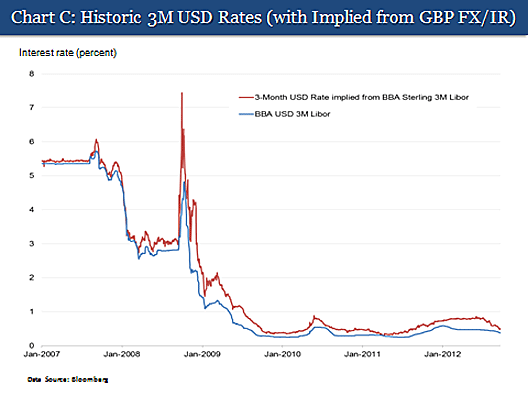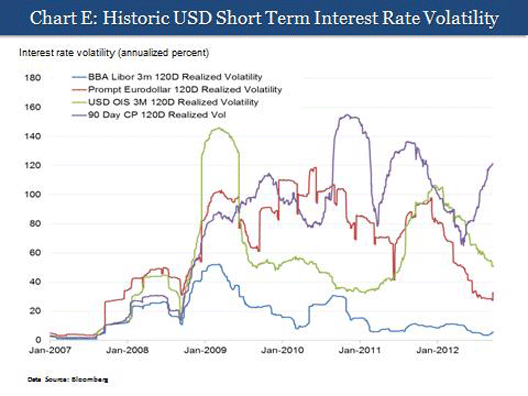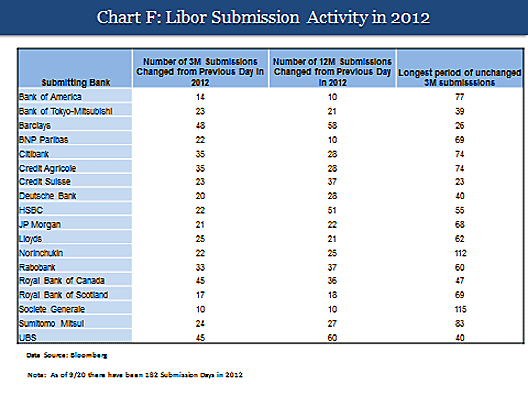In June, the financial markets were taken aback when the Barclays settlement was announced.
What were the systemic failures, how widespread is the problem, what action is being taken and what future reforms are necessary?
I will try to answer these questions.
How did it happen?
LIBOR is supposed to be the average rate at which the largest banks honestly believe they can borrow from one another unsecured, or without posting collateral. LIBOR was set up in the 1980s when banks regularly made loans to other banks on that basis.
There are at least three issues with LIBOR and other survey rates, such as Euribor, that I would like to discuss with you. The first and possibly the most significant issue with LIBOR is that the number of banks willing to lend to one another on an unsecured basis has been sharply reduced over the years.
This is because of a number of factors, including the economic turmoil beginning with the 2008 global financial crisis and continuing through today with the European debt crisis. In addition, due to regulatory capital and liquidity rules, unsecured interbank lending has become less attractive over the past number of years. Also, such lending has diminished because of the downgrading of large banks’ credit ratings. These factors have prompted a transition to more secured and shorter maturity funding, changing the supply and demand for interbank funding.
Martin Wheatley, Chief Executive Designate of the UK Financial Conduct Authority, issued a very thoughtful initial discussion paper in which he noted that of the ten currencies that are currently reported for LIBOR, the vast majority of borrowing periods have low transaction activity. For the U.S. dollar, the most liquid of all the ten currencies, there is little to no activity for more than half of the quoted LIBOR maturities.
At times during the financial crisis period, there was severe illiquidity in the London interbank money market, resulting in no interbank lending in certain tenors.
As Mervyn King, the governor of the Bank of England, said of LIBOR in 2008: “It is, in many ways, the rate at which banks do not lend to each other.”
Anecdotal reports from many market participants suggest that this has continued to be the case.
For a benchmark rate for any commodity – from financial to agricultural to energy – to be reliable and have integrity, it’s best to be anchored to real, observable transactions. It’s through real transactions between arm’s length buyers and sellers coming together in a marketplace that prices are discovered and set.
If benchmark rates don’t have transactions to rely on, the credibility and reliability of the benchmark is limited. When market participants submit for a benchmark rate lacking observable underlying transactions, even if operating in good faith, they may stray from what real transactions would reflect. Like walking in a dark forest, it’s easy to get lost, particularly over time. In addition, when a benchmark is separated from real transactions, it is more vulnerable to misconduct.
The second issue with LIBOR is that the banks that make LIBOR submissions to the British Bankers Association (BBA), an industry association, are doing so essentially without oversight. There are no rules requiring controls, firewalls, independent testing, policies and procedures, or a methodology ensuring that submissions are transaction-focused, as the benchmark was originally intended. There are no specific controls to prevent banks from intentionally or unintentionally herding together and reporting the same or similar rates based on information they share with each other or through intermediaries, such as inter-dealer brokers.
The third issue with LIBOR and similar interest rate benchmarks is that banks that submit their estimated borrowing rates naturally have inherent conflicts of interest. For instance, their trading positions are affected by the outcome of such surveys. These conflicts of interest must be properly managed.
Barclays Case
It is in this context that the Commodity Futures Trading Commission (CFTC) began to pursue the Barclays case in the spring of 2008. Media reports at the time had raised questions about the integrity of LIBOR.
CFTC attorneys painstakingly built a case that Barclays attempted to manipulate LIBOR and violated the Commodity Exchange Act’s (CEA) false reporting provision. CFTC Enforcement staff pored over millions of pages of documents and emails, listened to many, many hours of tape recordings, and interviewed multiple witnesses across the globe. The CFTC worked in close coordination with the United Kingdom’s Financial Services Authority (FSA) and the U.S. Department of Justice.
Ultimately, the CFTC uncovered a complex series of schemes, involving traders trying to manipulate not only U.S. dollar LIBOR, but LIBOR for other currencies, across multiple tenors, to benefit trading positions. The CFTC found a management directive to keep LIBOR submissions lower to protect Barclays’ reputation. In addition, the agency discovered serious illegal activity involving multiple banks that were sharing illegal requests to manipulate another benchmark, Euribor.
In addition to a record $200 million settlement, the CFTC’s Order against Barclays required the bank to implement measures designed to ensure the integrity of its benchmark submissions. These undertakings included, among other things, ensuring its submissions are based on a transaction-focused methodology and implementing firewalls to prevent improper communications.
These measures that were instituted in this CFTC enforcement action would be an improvement to the LIBOR process, particularly if based on sufficient observable transactions.
How extensive is the problem?
Naturally, people are wondering if the Barclays situation was isolated. The Barclays case highlights the broader issue: the underlying interbank market to which LIBOR and Euribor refer has significantly diminished.
Aside from the Barclays situation, market data raises questions about the integrity of LIBOR today.
First, why is U.S. Dollar LIBOR so different from U.S. Dollar Euribor? There are different panel banks that submit for LIBOR and Euribor, and U.S. Dollar Euribor has been calculated for a much shorter period of time — but do these factors alone explain why LIBOR is consistently half of Euribor?
Both rates are calculated on the basis of banks’ answers to questions about supposed borrowing rates. For LIBOR, panel banks are asked at what rate the bank thinks it can borrow, while for Euribor, a different set of panel banks are asked at what rate the bank thinks the average panel bank is able to borrow. And yet, as is demonstrated in Chart A, the Euribor rate for U.S. dollar borrowings is about twice as high as the comparable LIBOR.
Second, why have LIBOR and other benchmark rates typically not been aligned, since 2008, with the borrowing rates that would be implied by foreign exchange markets? A long-established financial theory known as interest rate parity says that the difference in interest rates between two countries should be roughly in line with the expected change in exchange rates between the countries’ currencies. If it isn’t, that opens an opportunity for arbitrage, the practice of taking advantage of price differences.
Until 2007, as the theory predicted, the difference between the borrowing rate in one currency and the lending rate in another could typically be derived from foreign currency exchange rates. In the last four years though, that generally has not been the case. There has been a divergence between theory and practice, which is evident when looking at the U.S. dollar borrowing rates implied from forward foreign currency exchange rates between the U.S. dollar and the euro, sterling or yen (see charts B, C and D).
Some market observers suggest this is because banks have been more hesitant since the financial crisis to use their balance sheets to take advantage of arbitrage opportunities. In addition, it has been suggested that demand for U.S. dollar borrowings by foreign banks has changed over the last few years, altering currency exchange rates.
To the extent that these observations are correct, however, why would these new market realities not be reflected in the rates that banks borrow from each other in the unsecured market, and similarly reflected in LIBOR?
Third, why is the volatility of the dollar-denominated LIBOR so much lower than the volatility of other dollar-denominated short-term interest rates? Just like stocks and bonds, short-term interest rates experience volatility — movement in levels within a day and across days. This is the natural course of a market that responds to and incorporates new information. In the last few years, there has been a lot of volatility in markets. But, as illustrated in Chart E, LIBOR has experienced much less severe swings than comparable rates. The same story of LIBOR having low volatility is the case whether looking at three-month submissions for LIBOR, as shown in Chart E, or looking at one-month submissions.
Another point about the limited volatility of LIBOR arises when looking at how often submitting banks change their daily submissions. Based on publicly available data, in 2009, the rates submitted daily by banks for three-month LIBOR had not changed 55 percent of the time. In 2011, the comparable submission had not changed 70 percent of the time.
In 2012 to date, the comparable submission had not changed 85 percent of the time. As Chart F shows, out of 182 LIBOR submission days in 2012, a majority of the banks changed their daily submissions fewer than 30 of those days. For a majority of the banks, five out of six days they did not change the rate. The same is generally true for submissions for one-month and one-week rates. Even with significant economic uncertainty in the markets this year, some banks go as long as three to five months without changing their submissions for individual rates.
Given that markets are volatile, why is LIBOR so stable?
Fourth, the one-year borrowing rates that many of the panel banks submit to the BBA for LIBOR do not appear to fully incorporate the market rates for their credit risk, as indicated by the rates for the institutions’ one-year credit default swaps.
There have been times when spreads in credit default markets have widened, sometimes substantially, for particular banks, suggesting a growing credit risk, even as those banks’ LIBOR submissions have remained relatively stable, suggesting that the banks’ reported cost of borrowing does not fully reflect the markets changing views of their credit risks. Though credit default markets can incorporate factors different from that of LIBOR, the significant difference between the two rates raises further questions regarding the reliability of the LIBOR process.
Similar questions arise when comparing the LIBOR banks’ submissions for one-year borrowings to yields on the same banks one-year unsecured bonds.
What is the healing process?
Given what the Barclays case has revealed, market participants, borrowers, lenders, and government officials are focusing on next steps and the healing process. Let me first discuss why the CFTC pursued the Barclays case.
Authorities
When the CFTC began to investigate the Barclays matter, the agency focused not only on questions about the decline of actual unsecured lending among banks, the supposed basis of LIBOR, but also on whether the conduct violated our founding statute, the CEA.
The CFTC regulates the derivatives marketplace, which includes commodity futures and swaps. Our mission is to ensure market integrity by promoting transparency and fair and orderly trading that is free from fraud, manipulation and other abuses. The CEA makes it unlawful to manipulate or attempt to manipulate the price of a commodity in interstate commerce, or the price of a futures or swaps contract. It is also unlawful to knowingly publish false information that tends to affect commodity prices. The U.S. Congress defined the word “commodity” in our statute broadly. An interest rate, like LIBOR, is a commodity under the CEA.
The Dodd-Frank Wall Street Reform and Consumer Protection Act gave the CFTC additional authority to prohibit an even broader swath of misconduct. The agency can now bring charges against anyone who recklessly employs a manipulative or deceptive device in connection with swaps, futures, or contracts for the sale of commodities.
As Europe considers legislation to enhance enforcement authority regarding benchmarks, Parliament might consider provisions similar to those we have in the United States. This would include making it unlawful to knowingly transmit false reports that tend to affect commodity prices, or otherwise to engage in manipulative or deceptive conduct in the markets and with respect to products in your jurisdiction. Such provisions can provide your regulators with additional authority to promote market integrity and protect market participants. Parliament also might consider making willful or intentional violations of these provisions a crime, just as is the case in the United States.
The Future of LIBOR
As we look to next steps, I believe it is critical that benchmark rates rely upon observable transactions. A rate that relies upon observable transactions is anchored by the reality of that price discovery. A rate that relies upon observable transactions has a lit path to credibility. A rate that relies upon observable transactions is less vulnerable to misconduct.
International regulators and market participants can and should work together collaboratively to improve LIBOR’s governance, manage the conflicts of interest and enhance the integrity of LIBOR reporting. Nevertheless, even if we address the issues of governance and conflicts of interest, we will still need to address the fundamental issue – that the underlying market for unsecured interbank borrowing has largely diminished. So much so that there may not be enough observable transactions in the unsecured interbank marketplace for people acting in good faith to accurately, estimate a rate for submission.
Thus, similar to a medical problem, which I have on my mind with my broken ribs, the question is can LIBOR be sufficiently mended, or is this a circumstance where it’s better to be replaced? Despite a long and painful recovery, sometimes replacement is the better choice when a hip or a knee … or even a benchmark rate … has worn out.
Among considerations are alternative benchmarks, particularly those that are based on deeper markets of observable transactions. Martin Wheatley presented in his discussion paper a number of these potential alternatives, including the overnight index swaps (OIS) rate, which is based on real transactions. Parts of the swaps market have already chosen to utilize this rate. The discussion paper also included an alternative based on actual short-term secured financings, such as repo rates, where loans have pledged collateral between banks and other financial institutions.
If the market were to move to a replacement benchmark rather than just mending LIBOR, it is crucial that the international process address an appropriate transition for people borrowing, lending or hedging based on LIBOR. Broad market input would be necessary to establish protocols and market mechanisms for such a transition. Any such transition should ensure that homeowners, commercial enterprises, and others with contracts indexed to LIBOR have an ability to smoothly migrate in a way over time so as to be least affected by a possible change.
It is critical that we work collaboratively to heal and repair the confidence in benchmark rates because such rates are at the center of the capital markets for borrowing, lending and hedging. The total notional value of global contracts indexed to LIBOR is about $300 trillion, of which about $10 trillion are loans. It is the reference rate for nearly half of adjustable-rate mortgages in the United States, for about 70 percent of the American futures market, and for a majority of the American swaps market.
Several international organizations will be examining and recommending approaches to these issues. This includes the Bank of International Settlements, which will provide input to the effort coordinated by the Financial Stability Board.
Another such task force was established by the International Organization of Securities Commissions (IOSCO), as market regulators are responsible for ensuring the transparency and integrity of markets for price discovery. Martin Wheatley and I have been asked to co-chair the IOSCO task force. This IOSCO task force will be informed by the responses to the European Commission’s Document on Regulation of Indices, as well as IOSCO’s Principles for Oil Price Reporting Agencies, which will be published in early October
Conclusion
People around the world saving for the future, using credit cards or borrowing money for tuition, cars and homes have a real stake in the integrity of LIBOR, Euribor and other such benchmarks. Commercial companies, municipalities and financial institutions hedging their interest rate risks have a real stake in the integrity of these rates. They deserve assurance that interest rates are set in a reliable and honest way. It is time for a new or revised benchmark — a healthy benchmark anchored in actual, observable market transactions — to restore the confidence of people around the globe that the rates at which they borrow and lend money and hedge interest rates are set honestly and transparently.
 Print
Print




